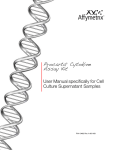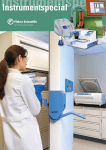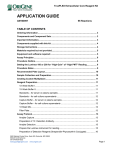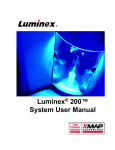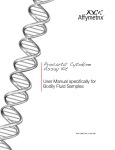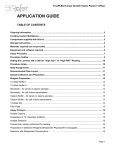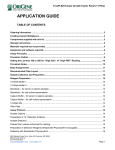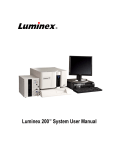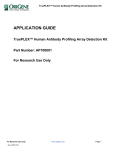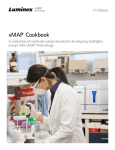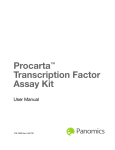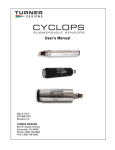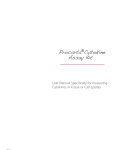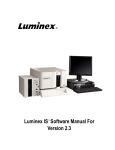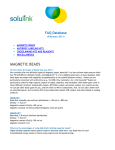Download ELISA Development Guide
Transcript
ELISA Development Guide A guide for the development of microplate and Luminex ELISA assays using OriGene’s ELISA and Luminex-validated antibodies rev022912 OriGene Technologies, Inc. 9620 Medical Center Drive, Suite 200, Rockville, MD 20850 www.origene.com [email protected] 1-301-340-3188 (P) 1-301-340-9254 (F) Page 1 rev022912 OriGene Technologies, Inc. 9620 Medical Center Drive, Suite 200, Rockville, MD 20850 www.origene.com [email protected] 1-301-340-3188 (P) 1-301-340-9254 (F) Page 2 Table of Contents ELISA Plate Coating .....................................................................................................................4 Materials .................................................................................................................................4 Antibody Plate Coating Procedure ...........................................................................................5 Basic ELISA Protocol ...................................................................................................................6 Materials .................................................................................................................................6 Recommended Plate Layout ....................................................................................................7 Preparation of Materials and Buffers ......................................................................................7 Detailed ELISA Assay Protocol .................................................................................................8 Data Analysis .........................................................................................................................10 ELISA Protocol Summary .......................................................................................................11 ELISA Assay Optimization .........................................................................................................12 ELISA Assay Troubleshooting ....................................................................................................15 Preparing Antibody-Coupled Luminex Beads ...........................................................................19 Materials and Equipment Required .......................................................................................19 Set-Up ...................................................................................................................................20 Procedure Notes ...................................................................................................................20 Coupling Procedure ...............................................................................................................21 Luminex Assay Protocol............................................................................................................23 Required or Recommended Reagents and Supplies...............................................................23 Equipment and software required: ........................................................................................24 Setting the Luminex 100 or 200 for “High Gain” or “High PMT” Reading ...............................25 Procedure Notes ...................................................................................................................25 Recommended Plate Layout ..................................................................................................26 Sample Collection and Preparation .......................................................................................26 Dilution of Samples ...............................................................................................................27 Reagent Preparation .............................................................................................................27 Assay Protocol .......................................................................................................................28 Data Analysis .........................................................................................................................31 Luminex ELISA Protocol Summary ............................................................................................32 Luminex Assay Optimization ....................................................................................................33 Luminex ELISA Troubleshooting ...............................................................................................36 Buffer and Reagent Preparation ...............................................................................................38 Plate Plan Template .................................................................................................................41 rev022912 OriGene Technologies, Inc. 9620 Medical Center Drive, Suite 200, Rockville, MD 20850 www.origene.com [email protected] 1-301-340-3188 (P) 1-301-340-9254 (F) Page 3 ELISA Plate Coating Materials Description Recommended Source ELISA Capture Antibody Coating Buffer ELISA Plate Plate Cover Post-Coat/Blocking Buffer OriGene Technologies, Inc. Prepared by user. See below and Buffer and Reagent Preparation. Corning Costar #2592 (or equivalent) Corning Costar #3930 (or equivalent) Prepared by user. See below and Buffer and Reagent Preparation. 5.5" x 7.0" Ziplock Mylar Bag Sorbent Systems #55MFS07OZE or 6-mil Ziplock™ bag, VWR # 82027-710 Sigma Cat. No. Z163562-100EA WYPALL X60 towels from Kimberly Clark Indicating Dessicant Absorbent Paper Towel Coating Buffer Each capture antibody has been tested with three different coating buffers. The optimal coating buffer for each antibody is listed on the antibody data sheet. The three coating buffers tested are listed below. Formulations and instructions for preparing them can be found in the last section of this document, or by following the hyperlinks. 100 mM Carbonate, pH 9.5 100 mM Borate, pH 8.5 100 mM Phosphate, pH 7.5 ELISA Plates OriGene ELISA-validated capture antibodies are tested on Corning-Costar High-Binding stripwell plates, #2592. Other Corning-Costar high-binding plates should give similar results. Similar plates from Nunc and Greiner may also give acceptable results, but should be tested for each application. Each ELISA assay will need to be optimized for a specific type and vendor of microplate. Post-Coat/Blocking Buffer After antibody coating, plates are coated with a buffer that blocks the plate from further binding and preserves the coated antibody. For some applications, it may be beneficial to add additional blocking proteins to this buffer such as BSA, animal IgG, gelatin, casein, or non-fat dry milk. To prepare, see: Post-Coat/Blocking Buffer. rev022912 OriGene Technologies, Inc. 9620 Medical Center Drive, Suite 200, Rockville, MD 20850 www.origene.com [email protected] 1-301-340-3188 (P) 1-301-340-9254 (F) Page 4 Storage of antibody-coated microplates Although we have not done extensive stability studies, antibody-coated plates are usually quite stable when stored dessicated in sealed mylar bags at 2-8ºC. If Mylar bags are not available, a 6-mil polyethylene Ziplock™ bag can also be used, but the desiccant will not last as long and will need to be replaced periodically. Antibody Plate Coating Procedure 1. Immediately before use, dilute antibody to recommended dilution in Coating Buffer. Antibody coating concentrations of 2-8 g/ml are typical, but may vary significantly for some antibodies. Do not store diluted antibody. 2. Add 70-100 l diluted antibody to each well. 3. Cover and incubate plates overnight at room temperature. Shaking is not usually necessary. 4. Aspirate liquid from wells so that no more than 5 l of diluted antibody remains. 5. If more than 5 l of diluted antibody remains, then tap plates sharply on absorbent paper towel to remove remaining liquid. 6. Add 250-300 l Post-Coat solution to each well. 7. Cover and incubate plates for 3-4 hours (or overnight at 4ºC). 8. Aspirate liquid from wells. If more than 5 l of Post Coat solution remains in the wells, then tap plates sharply on absorbent paper towel to remove remaining liquid. 9. Plates are then ready for immediate or same-day use. For later use, plates should be dried for 3-24 hours at room temperature and then stored in a sealed Mylar bag containing a pack of indicating desiccant. Antibody-coated plates can generally be stored desiccated at 2-8ºC for up to 6 months. rev022912 OriGene Technologies, Inc. 9620 Medical Center Drive, Suite 200, Rockville, MD 20850 www.origene.com [email protected] 1-301-340-3188 (P) 1-301-340-9254 (F) Page 5 Basic ELISA Protocol Materials Description Antibody coated microplate Recommended Source See previous section. Assay Buffer OriGene has four different Assay Buffers, each containing a different optimized mixture of buffer, salts, detergent and proteins. We recommend starting with Assay Buffer D. Different buffers may perform better than others depending upon the species origin of the capture and detection antibodies. For dilution of detection antibody, secondary antibodies, and streptavidin conjugates. Assay Buffer A - contains mouse and goat IgG Assay Buffer B- contains BSA Assay Buffer C- contains BSA and rabbit IgG Assay Buffer D- contains BSA, mouse and goat IgG rev022912 Part No.: AR100012 Part No.: AR100013 Part No.: AR100014 Part No.: AR100015 Assay Diluent OriGene, Part No.: AR100016 Serum-based diluent for dilution of standards and samples. Contains heat-activated animal serum, detergent and a preservative. Biotinylated Detection Antibody ELISA Wash Buffer (10X) Streptavidin-HRP Conjugate TMB Substrate, soluble, 1-part Stop Solution OriGene biotinylated detection antibodies are supplied at 0.5 mg/ml. OriGene Part No.: AR100010 (100 ml), AR100011 (1L) OriGene Part No.: AR100017 OriGene Part No.: AR100018 (100 ml), AR100019 (1L) OriGene Part No.: AR100020 (100 ml), AR100021 (1L) Absorbent paper towels WYPALL X60 towels Kimberly Clark OriGene Technologies, Inc. 9620 Medical Center Drive, Suite 200, Rockville, MD 20850 www.origene.com [email protected] 1-301-340-3188 (P) 1-301-340-9254 (F) Page 6 Recommended Plate Layout Before starting, it is recommended that a plate plan be designed. Such a plan will assist in assay workflow and data analysis. A suggested plate plan is shown below. A plate plan template is provided on page 41 (link here). 1 2 3 A Std 1 Std 1 Std 1 B Std2 Std2 Std2 C Std 3 Std 3 Std 3 D Std 4 Std 4 Std 4 E Std 5 Std 5 Std 5 F Std 6 Std 6 Std 6 G Std 7 Std 7 Std 7 H Neg Neg Neg 5 6 7 8 9 10 11 12 Std 1 is the highest concentration of the protein standard and Std 7 is the lowest concentration of the protein standard. The Negative wells contain the buffer or mixture that is used to dilute the standards. Running all standards, samples, and controls in duplicate or triplicate is recommended. Preparation of Materials and Buffers 1. Prepare Wash Buffer by diluting 10X Wash Buffer to 1X with deionized water. Store diluted wash buffer at 2-8ºC for up to one month. 2. For accurate quantitation, it is important to prepare protein standards in a matrix that mimics the composition of the samples. For example, if the samples are cell culture supernatants, then the protein standards should be prepared in the cell culture medium. For serum or plasma samples, dilute protein standards in OriGene Assay Diluent (AR100016) or similar serum- or plasma-based matrix. 3. The performance of an ELISA assay can vary dramatically depending upon the composition of the samples, particularly with serum, plasma and other samples of clinical origin. Samples of clinical origin may contain substances that inhibit the assay causing falsely low readings. Dilution of samples with an appropriate matrix may reduce some or all of the inhibition or interference. rev022912 OriGene Technologies, Inc. 9620 Medical Center Drive, Suite 200, Rockville, MD 20850 www.origene.com [email protected] 1-301-340-3188 (P) 1-301-340-9254 (F) Page 7 Example: a. Protein stock concentration is 385 g/ml. b. Samples to be tested are serum samples c. Sample volume per well is 50 l. d. Total volume added per well is 100 l. To prepare a 1 ug/ml stock, add 1.3 l of protein stock to 498.7 l of Assay Buffer. To prepare Standard 1 at 100 ng/ml, add 100 l of the 1 g/ml stock to 900 l of Assay Diluent. To Make Standard 2 Standard 3 Standard 4 Add 200 µl of Standard 1 200 µl of Standard 2 200 µl of Standard 3 To 400 µl of Assay Diluent 400 µl of Assay Diluent 400 µl of Assay Diluent Standard 5 Standard 6 Standard 7 200 µl of Standard 4 200 µl of Standard 5 200 µl of Standard 6 400 µl of Assay Diluent 400 µl of Assay Diluent 400 µl of Assay Diluent Conc. (ng/ml) 33.33 11.11 3.70 1.23 0.41 0.14 Detailed ELISA Assay Protocol 1. Dilute samples into Assay Diluent or an appropriate matrix so that the signals will fall within the linear range of the assay. 2. Add 100 μl prepared Standard to designated standard wells. 3. Add 100 μl Assay Diluent to Negative wells. 4. Add 100 μl diluted sample to designated sample wells. 5. Cover and incubate the plate for 1-2 hours at room temperature on an orbital plate shaker (500-700 rpm). 6. Ten to fifteen minutes before the end of this incubation, prepare working stock of Detection Antibody. Biotinylated detection antibody from OriGene is typically provided at 0.5 mg/ml. Check antibody data sheet for recommended working concentration. Typical working concentrations for colorimetric assays range from 0.5 to 2.0 g/ml. Lower working concentrations may be suitable for chemiluminescent assays. Example: a. Biotinylated detection antibody stock is 0.5 mg/ml. b. Working biotinylated detection antibody concentration is 1 g/ml. c. Prepare 100 l per well plus 10% extra. rev022912 OriGene Technologies, Inc. 9620 Medical Center Drive, Suite 200, Rockville, MD 20850 www.origene.com [email protected] 1-301-340-3188 (P) 1-301-340-9254 (F) Page 8 d. Assay uses 48 wells. e. Volume Assay Diluent required = 48*100*1.1 = 5280 l f. Volume detection antibody required = 5280 * 1/500 = 10.56 l Add 10.56 l biotinylated detection antibody to 5280 l of Assay Buffer. 7. Aspirate solution from wells. 8. Wash wells 3-5 times with 200-300 l of 1X Wash Buffer. If using an automated plate washer, fill wells completely before aspiration. After final wash, tap plate thoroughly on absorbent paper to remove all traces of wash buffer from the wells. 9. Add 100 μl working stock of Detection Antibody to each well. 10. Cover and incubate the plate for 1 hour at room temperature on an orbital plate shaker at 500-700 rpm. 11. Ten to fifteen minutes before the end of this incubation, prepare the working solution of streptavidin-HRP (SA-HRP). A typical working concentration range for colorimetric assays is from 0.1 to 2.0 g/ml. Lower working concentrations may be suitable for chemiluminescent assays. Example: a. Streptavidin HRP stock is 1.0 mg/ml. b. Working streptavidin-HRP concentration is 0.5 g/ml. c. Prepare 100 l per well plus 10% extra. d. Assay uses 48 wells. e. Volume Assay Diluent required = 48*100*1.1 = 5280 l f. Volume SA-HRP stock required = (0.5/1000) * 5280 = 2.64 l Add 2.64 l of streptavidin-HRP to 5280 l of Assay Diluent. 12. Wash wells 3-5 times with 200-300 l of 1X Wash Buffer. If using an automated plate washer, fill wells completely before aspiration. After final wash, tap plate thoroughly on absorbent paper to remove all traces of wash buffer from the wells. 13. Add 100 l of diluted streptavidin-HRP to each well. 14. Incubate plate at room temperature for 30 minutes on an orbital plate shaker at 500700 rpm. 15. Wash wells five times with 200-300 l of 1X Wash Buffer. If using an automated plate washer, fill wells completely before aspiration. 16. After final wash, tap plate sharply on clean absorbent paper to remove all traces of wash buffer from the wells. 17. Add 100 l soluble TMB substrate to each well. 18. Cover the plate and incubate plate at room temperature for 15-30 minutes. rev022912 OriGene Technologies, Inc. 9620 Medical Center Drive, Suite 200, Rockville, MD 20850 www.origene.com [email protected] 1-301-340-3188 (P) 1-301-340-9254 (F) Page 9 19. Add 100 l of Stop Solution to each well. Incubate for 1-2 minutes. 20. Read the absorbance at 450 nm. Data Analysis 1. Use commercial data analysis software to analyze the data as analysis of ELISA data with Excel can be quite difficult. Many plate readers are sold with a software package that can be used to perform the analysis. Stand-alone analysis software is also available. ReaderFit from MiraiBio (Hitachi), Prism from GraphPad, and SigmaPlot from Systat are all suitable. A free (but limited) web-based analysis package is available at www.readerfit.com. 2. Generate a standard curve by fitting the results of the protein standard data to a model equation. 3. For microplate ELISA data, generally a 4-parameter logistic (4-PL) model gives a good fit. For some assays, a 5-parameter logistic (5-PL) model may give a better fit than the 4-PL model. 4. To account for greater variance at the low end of the curve, it is recommended to consider 1/Y or 1/Y2 weighting in conjunction with the 4-PL or 5-PL models. 5. Use the standard curve to calculate the concentration of the analytes in the samples (unknowns). Be sure to adjust for any dilution of the samples relative to the standards. 6. The following on-line articles provide additional in-depth discussion and analysis of the various factors and parameters to consider for ELISA data analysis. rev022912 Tips for ELISA Data Analysis The 4 Parameter Logistic Regression Model The 5 Parameter Logistic Regression Model The Importance of Weighting with 4PL and 5PL Regression Models OriGene Technologies, Inc. 9620 Medical Center Drive, Suite 200, Rockville, MD 20850 www.origene.com [email protected] 1-301-340-3188 (P) 1-301-340-9254 (F) Page 10 ELISA Protocol Summary 1. Prepare standards and samples. 2. Add 100 μl standards and samples to designated wells of capture plate. 3. Cover and incubate the capture plate for 1-2 hours at room temperature on an orbital plate shaker (500-700 rpm). Prepare detection antibody. 4. Wash wells 3-5 times with 200-300 l of 1X Wash Buffer. 5. Add 100 μl Detection Antibody to each well. 6. Cover and incubate the plate for 1 hour at room temperature on an orbital plate shaker at 500-700 rpm. Prepare streptavidin-HRP solution at end of incubation. 7. Wash wells 3-5 times with 200-300 l of 1X Wash Buffer. 8. Add 100 l of diluted streptavidin-HRP to each well. 9. Incubate plate at room temperature for 30 minutes on an orbital plate shaker at 500700 rpm. 10. Wash wells five times with 200-300 l of 1X Wash Buffer. 11. Add 100 l soluble TMB substrate to each well. 12. Incubate plate at room temperature for 15-30 minutes. 13. Add 100 l of Stop Solution to each well. 14. Read absorbance at 450 nm. rev022912 OriGene Technologies, Inc. 9620 Medical Center Drive, Suite 200, Rockville, MD 20850 www.origene.com [email protected] 1-301-340-3188 (P) 1-301-340-9254 (F) Page 11 ELISA Assay Optimization Assays can be optimized for many different purposes such as maximum sensitivity, widest dynamic range, maximum specificity, improved linearity or recovery, or shortest time to results. Some common assay parameters that can be modified to achieve an optimal assay are listed in the table below. Parameter Modification Possible Effects Antibody Coating Concentration Increased Antibody Coating Concentration Decreased Post-Coat/Blocking Buffer Addition of a protein such as BSA, IgG, gelatin or casein at a concentration of 0.1 – 10 mg/ml Higher signal Higher background Lower limit of detection Faster capture Lower signal Lower background Wider dynamic range Longer capture time required Lower background Lower limit of detection Improved recovery Improved stability Alternate Buffer and salt concentration Plate Type (Binding) Plate Type (Color) Plate Vendor Sample and Standard Diluent Standard Concentrations rev022912 Alternate detergent and/or detergent concentration. High-binding vs Low-binding Use of White or Black plates instead of clear with fluorescent or chemiluminescent detection Use ELISA plates from different vendors Samples and standards can be diluted into a different assay matrix. Standard can be diluted over different ranges Difficult to predict but may significantly affect assay performance Higher signal Higher sensitivity Wider dynamic range Difficult to predict. Plates from different vendors may give different results under identical assay conditions. Increased recovery Increased linearity Increased sensitivity Wider dynamic range Different dynamic range OriGene Technologies, Inc. 9620 Medical Center Drive, Suite 200, Rockville, MD 20850 www.origene.com [email protected] 1-301-340-3188 (P) 1-301-340-9254 (F) Page 12 Parameter Sample concentrations Modification Samples can be used undiluted or can be diluted to different concentrations in an assay matrix Possible Effects Increased recovery Optimal linearity Increased sensitivity Composition of Assay Matrix Addition of blocking agents such as proteins, polymers, or additional detergents Increased recovery Increase or decrease the salt (NaCl) concentration in the buffers Increased sensitivity Optimal linearity Reduced sample interference Increase or decrease in the pH of the buffer Capture time Number of Washes: Post-Capture Composition of Wash Buffer Alternate buffers: Tris, borate, MES Increase or decrease Increase or decrease Increased or decreased sensitivity. Wider dynamic range Increased or decreased signal and/or background. Increased or decreased salt concentration Increased or decreased assay time. Increased or decreased signal and/or background. Increased or decreased pH Increased sensitivity Increased or decreased detergent concentration Alternate dynamic range Reduced sample interference Different buffer (Tris, etc.) Improved recovery Biotinylated detection antibody concentration rev022912 Different detergent Increase or decrease Increased or decreased signal Increased or decreased sensitivity Wider or smaller dynamic range OriGene Technologies, Inc. 9620 Medical Center Drive, Suite 200, Rockville, MD 20850 www.origene.com [email protected] 1-301-340-3188 (P) 1-301-340-9254 (F) Page 13 Parameter Composition of the biotinylated detection antibody diluent Modification Addition of blocking agents such as proteins, polymers, or additional detergents. Possible Effects Increased recovery Increase or decrease in the salt (NaCl) concentration Increased sensitivity Increased linearity Reduced sample interference Increase or decrease in the buffer pH Alternate buffers: Tris, borate, MES Detection antibody incubation time Composition of the streptavidin-HRP conjugate diluent Alternate buffer concentrations Increase or decrease. Addition of blocking agents such as proteins, polymers, or additional detergents Increase or decrease in the salt (NaCl) concentration. Increase or decrease in the buffer pH Increased or decreased signal Increased or decreased sensitivity Altered dynamic range Increased or decreased signal Increased or decreased sensitivity Increased or decreased dynamic range Increased or decreased detection time Alternate buffers: Tris, borate, MES Streptavidin-HRP conjugate concentration rev022912 Alternate buffer concentrations Increase or decrease Streptavidin-HRP incubation time Increase or decrease Number of washes after Streptavidin-HRP incubation Increase or decrease Increased or decreased signal Increased or decreased sensitivity Alternate dynamic range Increased or decreased signal Increased or decreased sensitivity Increased or decreased signal and/or background. OriGene Technologies, Inc. 9620 Medical Center Drive, Suite 200, Rockville, MD 20850 www.origene.com [email protected] 1-301-340-3188 (P) 1-301-340-9254 (F) Page 14 ELISA Assay Troubleshooting Problem Possible Causes Solutions High Background Insufficient washing Increase number of washes. Add 1-5 minute soak step between washes. Increase the volume of wash buffer per well. If using a plate washer, check to ensure that all ports are clean and that the target volume is delivered to all wells. Check that the residual volume after aspiration is less than 5 l per well. Detection antibody concentration is too high Check dilution. Titrate to find the optimal concentration. Use a medium-binding plate from a reliable source (Costar, Nunc, Greiner). No Signal or Low Signal rev022912 Streptavidin-HRP conjugate concentration is too high Check dilution. Titrate to find the optimal concentration. Non-specific interactions Add additional protein to assay buffers and wash buffer. Contaminated buffers Remake buffers. Non-binding (eg, tissue culture) microplate used for antibody coating Use a high-binding plate from a reliable source (Costar, Nunc, Greiner) Diluted capture antibody stored in coating buffer for extended period before coating. Dilute antibody into coating buffer immediately before use. Do not store diluted capture antibody. Reagents omitted or added in incorrect order Check calculations and protocol. Re-make solutions. Repeat assay. Incorrect standard was used or standard dilutions were made incorrectly Verify that the correct standard was used. Check calculations for standard dilutions. Re-dilute standards. Inhibition of HRP by azide Make sure that the SA-HRP dilution buffer or final wash buffer does not contain azide. Concentration of Detection Antibody or Streptavidin-HRP is too low. Check dilution. Titrate to find the optimal concentration. OriGene Technologies, Inc. 9620 Medical Center Drive, Suite 200, Rockville, MD 20850 www.origene.com [email protected] 1-301-340-3188 (P) 1-301-340-9254 (F) Page 15 Problem Possible Causes Solutions No Signal or Low Signalcontinued Capture antibody coated at too low a concentration Titrate coating antibody concentration to determine optimal coating level. Incorrect wavelength used in plate reader Read plate at 450 nm for yellow color (with stop solution). Read plate at 650 nm for blue color (without stop solution). Insufficient color development time Increase color development time until background is visible in the Negative Standard. Final washing step skipped or insufficient – unbound HRP remains in the wells Wash plates thoroughly according to the protocol. Increase the number of washes. Increase the volume of wash buffer used per well. Substrate contaminated Use a fresh bottle of substrate. Pour required amount of substrate into a new reagent reservoir. Do not return unused substrate to the bottle. Detection Antibody Concentration is too high Check dilution. Titrate to find the optimal concentration. Streptavidin-HRP Conjugate Concentration is too high. Check dilution. Titrate to find the optimal concentration. Plate sealers or reagent reservoirs contaminated by residual buffer or reagents Use a fresh plate sealer and reagent reservoir for each step. Insufficient washing Increase number of washes. Add 1-5 minute soak steps between washes. Increase the volume of wash buffer per well. Too much signal – plate is uniformly blue or yellow. If using a plate washer, check to ensure that all ports are clean and that the target volume is delivered to all wells. Check that the residual volume after aspiration is less than 5 l per well. Pipettors or plate washer are contaminated rev022912 Clean pipettors and plate washer thoroughly. Test for residual HRP activity. OriGene Technologies, Inc. 9620 Medical Center Drive, Suite 200, Rockville, MD 20850 www.origene.com [email protected] 1-301-340-3188 (P) 1-301-340-9254 (F) Page 16 Problem Possible Causes Solutions Poor reproducibility of duplicates Uneven concentration of antibody across the plate Check coating and blocking volumes. Check dispensing equipment. Incubate plate in a uniform environment. Use a high-binding microplate from a different vendor. Increase coating concentration. Extend blocking time to overnight. Insufficient washing Increase number of washes. Add a 1-5 minute soak steps with each wash. Increase the volume of wash buffer per well. If using a plate washer, check to ensure that all ports are clean and that the target volume is delivered to all wells. Check that the residual volume after aspiration is less than 5 l per well. Buffers contaminated Make fresh buffers. Use new reagent reservoirs for each reagent. If using a plate washer, clean, decontaminate, and use fresh wash buffer. Well-to-well carryover (from standards or positive samples) Adjust shaker speed to minimize carryover. Completely seal wells with a plate sealer between steps or use a plate cover with individual rings that separate wells. Use a fresh plate sealer for each incubation. Poor assay-toassay reproductibility Insufficient or inconsistent washing Increase number of washes. Add a 1-5 minute soak steps with each wash. Increase the volume of wash buffer per well. If using a plate washer, check to ensure that all ports are clean and that the target volume is delivered to all wells. Check that the residual volume after aspiration is less than 5 l per well. rev022912 OriGene Technologies, Inc. 9620 Medical Center Drive, Suite 200, Rockville, MD 20850 www.origene.com [email protected] 1-301-340-3188 (P) 1-301-340-9254 (F) Page 17 Problem Possible Causes Insufficient or inconsistent washing Poor assay-toassay reproductibilitycontinued Variations in incubation times or temperatures Solutions For manual washing, decanting technique may affect assay results. Develop a consistent procedure. Run assay in a consistent environment. All assay incubation times must be consistent from assay to assay. Incorrect dilution of protein standards Check dilutions. Re-dilute and re-run assay. Variation in equipment used Use the same equipment from assay to assay including pipettors, shaker, plate washer, plate reader. Difference in the standard curve calculation Use the same equation to fit the standard curve. Samples are all above the linear range of the standard curve Analyte concentration in samples is too high Dilute samples are re-run. Assay sensitivity is not optimized for the natural range of the analyte Reduce detection antibody concentration. Reduce concentration of streptavidin-HRP. Reduce capture and detection incubation times. Re-dilute the protein standards to cover the appropriate range of the analyte. Standard curve is fine, but all samples are very low or negative No analyte in sample or analyte is present at a level below the limit of detection. Increase the amount of sample used per well. Decrease the dilution factor of the samples. Samples may contain an inhibitory factor Spike a negative sample with protein standard and measure the recovery. Dilute samples 1:2 or further. rev022912 OriGene Technologies, Inc. 9620 Medical Center Drive, Suite 200, Rockville, MD 20850 www.origene.com [email protected] 1-301-340-3188 (P) 1-301-340-9254 (F) Page 18 Preparing Antibody-Coupled Luminex Beads Materials and Equipment Required Description Recommended Source Filter Plate (for Bead Coupling) Aluminum Plate Sealer OriGene Part No. AR100012 contains 5 filter plates and 15 plate sealers. OriGene Part No. AR100012 contains 5 filter plates and 15 plate sealers. Pierce (Thermo Fisher) # 22980 (store dessicated at -20ºC) Pierce (Thermo Fisher) # 24510 (store dessicated at -20ºC) Luminex Corp (www.luminexcorp.com), MiraiBio (www.miraibio.com), or Bio-Rad (www.bio-rad.com) EDC Sulfo-NHS Luminex MicroPlex® or MagPlex® Microspheres ELISA Capture Antibody NaH2PO4 (Sodium phosphate monobasic, anhydrous) Water, Ultra-pure rev022912 OriGene Technologies. Capture antibodies are supplied at 0.5 mg/ml. Sigma # S3139 Invitrogen # 10977 or equivalent MES Buffer Sigma # M2933 5N NaOH Tween-20 BSA 10X PBS Sodium Azide ThermoFisher# SS256-500 Sigma # P9416 Sigma # A7888 EMD Chemicals # 6506 or equivalent Sigma # S8032 ELISA Wash Buffer (10X) Activation Buffer Coupling Buffer Blocking Buffer Microplate vacuum manifold OriGene Part No.: AR100010 (100 ml), AR100011 (1L) 100 mM Phosphate, pH 6.2 (see Buffer and Reagent Preparation) 50 mM MES, pH 5.0 (see Buffer and Reagent Preparation) (see Buffer and Reagent Preparation) Pall #5017 Multi-well plate vacuum manifold (or equivalent) Vacuum pump or vacuum source Dessicant containers Absorbent paper towel Millipore WP6111560 Chemical Duty Pump, 115 V/60 Hz or equivalent Plastic or glass containers containing dessicant. WYPALL X60 towels from Kimberly Clark OriGene Technologies, Inc. 9620 Medical Center Drive, Suite 200, Rockville, MD 20850 www.origene.com [email protected] 1-301-340-3188 (P) 1-301-340-9254 (F) Page 19 Set-Up Determine the wells to be used for coupling. Cover remaining wells with an aluminum Plate Sealer. It is most convenient to use wells in groups of 8 (columns) and to use an 8-channel pipettor for addition of reagents. The following protocol is designed for coupling of 0.5 - 8 g of antibody to 100-150 l (1.25-1.9 x 106 ) of activated beads in a total volume of 150 l. An example plate layout is shown below. In this example, 4 different antibodies are being coupled at four different coupling ratios: 1.0, 2.0, 3.0, and 4.0 g of antibody per well. Couple each antibody to a different bead region (0100) so that all coupled beads can be assayed simultaneously. 1 2 A Ab1-1 Ab3-1 B Ab1-2 Ab3-2 C Ab1-3 Ab3-3 D Ab1-4 Ab3-4 E Ab2-1 Ab4-1 F Ab2-2 Ab4-2 G Ab2-3 Ab4-3 H Ab2-4 Ab4-4 3 5 6 7 8 9 10 11 12 Wells covered by Aluminum Plate Sealer Procedure Notes 1. The vacuum pressure on the vacuum manifold should not exceed 5 mm Hg. Optimal filtration occurs between 1 and 4 mm Hg. 2. The fluorescent beads are light sensitive and are especially sensitive to direct sunlight and incandescent light. Use aluminum foil to cover plates and tubes. Store plates in a dark location during incubations. 3. After vacuum filtration, blot the bottom of the filter plate on clean absorbent material such as WYPALL X60 towels from Kimberly Clark. 4. During loading or incubations do not place the filter plate on absorbent material as liquid will be drawn through the plate by wicking. rev022912 OriGene Technologies, Inc. 9620 Medical Center Drive, Suite 200, Rockville, MD 20850 www.origene.com [email protected] 1-301-340-3188 (P) 1-301-340-9254 (F) Page 20 Coupling Procedure Step 2 Add 100 l 1X Wash Buffer to each well of the filter plate. Vacuum gently and blot. Vortex bead stock for 10 seconds at high speed Step 3 Add 100-125 l of Bead Stock to each well of the filter plate Step 4 Vacuum gently and blot. Step 5 Wash beads 2 Times with 200 l Activation Buffer. Step 6 Vacuum gently and blot. Step 7 Add 80 l Activation Buffer to each well. Step 8 Shake plate at 1000 rpm for at least 5 minutes. Step 9 Prepare 50 mg/ml Sulfo-NHS in water. Step 10 Step 17 Add 10 l of the 50 mg/ml Sulfo-NHS to each well. Prepare a 50 mg/ml solution of EDC in water. Work quickly as EDC is not stable in water. Add 10 l of the 50 mg/ml EDC to each well. Work quickly as EDC is not stable in water. Mix wells by pipetting up and down 5 times. Shake plate for 20-30 minutes @ 600-1000 rpm in the dark or covered with a dark cover. Mix wells by pipetting up and down 5 times. Shake plate for 20-30 minutes @ 600-1000 rpm in the dark or covered with a dark cover. Wash Beads 3 Times with 200 l Coupling Buffer. Step 18 Vacuum gently and blot. Step 19 Step 21 Add 146 l Coupling Buffer to each well. Add 2.0 l of antibody solution to the 1.0 g antibody wells. Add 4.0 l of antibody solution to the 2.0 g antibody wells. Add 6.0 l of antibody solution to the 3.0 g antibody wells. Add 8.0 l of antibody solution to the 4.0 g antibody wells. Mix wells by pipetting up and down 5 times. Step 22 Mix for 1 hour with shaking at 600 RPM. Step 23 Mix wells by pipetting up and down 5 times. Step 24 Mix for 1-3 hours with shaking at 600 RPM. Step 25 Vacuum gently. Step 26 Wash 3 Times with 250 l Blocking Buffer. Step 27 Vacuum gently and blot. Step 1 Step 11 Step 12 Step 13 Step 14 Step 15 Step 16 Step 20 rev022912 OriGene Technologies, Inc. 9620 Medical Center Drive, Suite 200, Rockville, MD 20850 www.origene.com [email protected] 1-301-340-3188 (P) 1-301-340-9254 (F) Page 21 Step 29 Step 30 Step 31 Step 32 Step 33 rev022912 Add 100 l Blocking Buffer to each well One well at a time, mix wells by pipetting up and down 5 times and then remove the solution containing suspended beads from the well. Transfer the solution ( 100 l) to a new labeled tube. Store beads @ 4ºC in the dark. (Optional). Count the beads to determine the bead concentration using a hemocytometer or a particle counting instrument such as a Cellometer. Alternatively, assume the beads are at a concentration of 10,000 beads per l and adjust the concentration after initial testing. OriGene Technologies, Inc. 9620 Medical Center Drive, Suite 200, Rockville, MD 20850 www.origene.com [email protected] 1-301-340-3188 (P) 1-301-340-9254 (F) Page 22 Luminex Assay Protocol Required or Recommended Reagents and Supplies Description Recommended Source Filter Plate OriGene Part No. AR100012 contains 5 filter plates and 15 plate sealers. OriGene Part No. AR100012 contains 5 filter plates and 15 plate sealers. Prepared as described in the coupling procedure. Aluminum Plate Sealer Luminex beads coupled with an OriGene capture antibody Biotinylated Detection Antibody Recombinant Protein for use as a protein standard Assay Buffer For dilution of detection antibody, secondary antibodies, and streptavidin conjugates. Assay Buffer AAssay Buffer BAssay Buffer CAssay Buffer D- OriGene Detection antibodies are supplied at 0.5 mg/ml. OriGene proteins purified from HEK293 cells. OriGene over-expression HEK293 Cell Lysates. OriGene has four different Assay Buffers, each containing a different optimized mixture of buffer, salts, detergent and proteins. We recommend starting with Assay Buffer D. Different buffers may perform better than others depending upon the species origin of the capture and detection antibodies. contains mouse and goat IgG contains BSA contains BSA and rabbit IgG contains BSA, mouse and goat IgG Part No.: Part No.: Part No.: Part No.: AR100012 AR100013 AR100014 AR100015 Assay Diluent OriGene, Part No.: AR100016 Serum-based diluent for dilution of standards and samples. Streptavidin-Phycoerythrin Conjugate Contains heat-activated animal serum, detergent and a preservative. Moss PN: SAPE-001 1 mg/ml stock or OriGene PN: AM100109 2 vials of 10X (30 g/ml) solution of streptavidin-PE in stabilizing buffer for use with Luminex immunoassays. Makes a 3 g/ml solution when diluted to 1X. Sufficient quantity for 192 assays. rev022912 OriGene Technologies, Inc. 9620 Medical Center Drive, Suite 200, Rockville, MD 20850 www.origene.com [email protected] 1-301-340-3188 (P) 1-301-340-9254 (F) Page 23 Equipment and software required: rev022912 Description Recommended Supplier & Catalog No. Luminex 100™, 200™ or equivalent Luminex, Millipore, Hitachi, Bio-Rad Luminex Data Acquisition Software xPONENT 3.1 Luminex IS 2.3 Luminex LDS 1.7 BioPlex Manager Vortex Mixer VWR Analog Vortex Mixer 58816-121 (120V) 58816-123 (230V) Mini centrifuge VWR Minifuge 93000-196 (120V) 93000-198 (230V) Orbital Shaker Eppendorf Mix Mate 022674200 (120V/60Hz) 022674226 (230V/50Hz) Water Bath Sonicator Bransonic Model B3/B5 000-951-005 (Model B3, 115V) 000-951-103 (Model B5, 230V) Microplate vacuum manifold with pressure gauge Pall Multi-well plate vacuum manifold (PN 5017). Data Analysis Software MasterPlex QT from Hitachi Software or equivalent. A free trial download is available. OriGene Technologies, Inc. 9620 Medical Center Drive, Suite 200, Rockville, MD 20850 www.origene.com [email protected] 1-301-340-3188 (P) 1-301-340-9254 (F) Page 24 Note : To achieve optimal results, the use of the “High Gain” or “High PMT” setting on the Luminex 100 or 200 is recommended. Some instruments may use this setting as the default. Check with your instrument supplier for more information. Setting the Luminex 100 or 200 for “High Gain” or “High PMT” Reading 1. Create a new lot number for Cal 2 and enter it into the Luminex software as a new Cal 2 lot number (use the actual lot number with an HG at the end to designate High Gain). 2. Record the Cal 2 target value, which is usually around 3800. 3. Multiply the Cal 2 target value by 4.55 to get a new Target value of approximately 17,290. 4. Enter the new Target Value as the value for your "New" Cal 2 lot. 5. Run the Cal 2 Calibration. Procedure Notes 1. The vacuum pressure on the vacuum manifold should not exceed 5 mm Hg. Optimal filtration occurs between 1 and 4 mm Hg. 2. The fluorescent beads are light sensitive and are especially sensitive to direct sunlight and incandescent light. Use aluminum foil to cover plates and tubes. Store plates in a dark location during incubations. 3. After vacuum filtration, blot plates on clean absorbent material such as WYPALL X60 towels from Kimberly Clark. 4. During loading or incubations do not place the filter plate on absorbent material as liquid will be drawn through the plate by wicking. rev022912 OriGene Technologies, Inc. 9620 Medical Center Drive, Suite 200, Rockville, MD 20850 www.origene.com [email protected] 1-301-340-3188 (P) 1-301-340-9254 (F) Page 25 Recommended Plate Layout Before starting, it is recommended that a plate plan be designed. Such a plan will assist in assay workflow and data analysis. A suggested plate plan is shown below. A plate plan template is provided in the appendix. 1 2 3 A Std 1 Std 1 Std 1 B Std2 Std2 Std2 C Std 3 Std 3 Std 3 D Std 4 Std 4 Std 4 E Std 5 Std 5 Std 5 F Std 6 Std 6 Std 6 G Std 7 Std 7 Std 7 H Neg Neg Neg 5 6 7 8 9 10 11 12 Sample Wells Std 1 is the highest concentration and Std 7 is the lowest concentration. Running all standards, samples, and controls in duplicate or triplicate is recommended. Sample Collection and Preparation 1. Serum, plasma and tissue culture supernatants are common sample types and will generally be suitable for testing with this protocol. Protocols for additional sample types will need to be tested and validated. 2. Avoid the use of lipemic or hemolyzed samples. 3. Collect serum and plasma samples according to standard protocols. Immediately mix and separate, and then aliquot the samples into polypropylene tubes. If not tested immediately, store samples at -80ºC. 4. Analyze fresh samples as quickly as possible after collection. Allow frozen samples to thaw on ice, then mix well before testing. Avoid multiple freeze-thaw cycles of frozen samples. 5. Turbid samples should be clarified by centrifugation before use. 6. If the measured analyte concentrations exceed the value of the upper range of the standard curve, dilute samples appropriately and reanalyze. Dilute serum and plasma samples in Assay Diluent or Assay Buffer. Dilute tissue culture supernatants in tissue culture medium or Assay Buffer. rev022912 OriGene Technologies, Inc. 9620 Medical Center Drive, Suite 200, Rockville, MD 20850 www.origene.com [email protected] 1-301-340-3188 (P) 1-301-340-9254 (F) Page 26 7. For accurate quantitation, it is important that the composition of the standards be exactly the same as the composition of the samples. Dilute the standards in a buffer that reflects the final composition of the samples after dilution. Dilution of Samples It is important to dilute the samples so that the analyte levels are within the linear range of the assay and to minimize the effect of the sample matrix on the sample assay. Reagent Preparation 1. Prepare Wash Buffer by diluting 10X Wash Buffer to 1X with deionized water. Store diluted wash buffer at 2-8ºC for up to one month. 2. For accurate quantitation, it is important to prepare protein standards in a matrix that mimics the composition of the samples. For example, if the samples are cell culture supernatants, then the protein standards should be prepared in the cell culture medium. For serum or plasma samples, dilute protein standards in OriGene Assay Diluent (AR100016) or similar serum- or plasma-based matrix. 3. The performance of a Luminex ELISA assay can vary dramatically depending upon the composition of the samples, particularly with serum, plasma and other samples of clinical origin. Samples of clinical origin may contain substances that inhibit the assay causing falsely low readings. Dilution of samples with an appropriate matrix may reduce some or all of inhibition or interference. Example – Serum Samples: a. Protein stock concentration is 385 g/ml. b. Samples to be tested are serum samples. c. Sample volume per well is 50 l. d. Total volume added per well is 100 l. Assay matrix is a mixture of 50% cell Assay Diluent and 50% Assay Buffer B. To prepare a 1 ug/ml stock, add 1.3 l of protein stock to 498.7 l of Assay Buffer B. To prepare Standard 1 at 100 ng/ml, add 100 l of the 1 g/ml stock to 900 l of Assay Matrix. rev022912 To Make Add To Conc. (ng/ml) Standard 2 Standard 3 200 µl of Standard 1 200 µl of Standard 1 400 µl of Assay Matrix 400 µl of Assay Matrix 33.33 11.11 Standard 4 200 µl of Standard 1 400 µl of Assay Matrix 3.70 OriGene Technologies, Inc. 9620 Medical Center Drive, Suite 200, Rockville, MD 20850 www.origene.com [email protected] 1-301-340-3188 (P) 1-301-340-9254 (F) Page 27 Standard 5 Standard 6 200 µl of Standard 1 200 µl of Standard 1 400 µl of Assay Matrix 400 µl of Assay Matrix 1.23 0.41 Standard 7 200 µl of Standard 1 400 µl of Assay Matrix 0.14 Filter Plate Before starting the assay, cover the wells that will not be used in the assay with an aluminum plate sealer. Press sealer down so that all wells are tightly sealed. Trim edges with a razor blade. Bead Mix Prepare Bead Mix in Assay Buffer or 1X Wash Buffer containing 1 mg/ml BSA. Dilute beads to a final concentration of 25 beads per µl. Example: a. Bead stocks are at a concentration of 10,000 per µl. b. Prepare 100 l per well plus 10% extra. c. Assay uses 48 wells. d. Volume Assay Buffer B required = 48*100*1.1 = 5280 l e. Volume bead stock required = 5280 * 25/10,000 = 13.2 l Add 13.2 l of each bead stock to 5280 l of Assay Buffer B. f. When all beads have been added, vortex thoroughly for 10 seconds and then sonicate for 2 minutes. Assay Protocol Analyte Capture 1. Briefly vortex the 1X Bead Mix. Add 100 μl of 1X Bead Mix to each assay well (this is approximately 2500 beads of each type per well). 2. Remove liquid from the plate by gentle vacuum. Blot plate thoroughly on absorbent paper. 3. Add 100 μl diluted standards into designated standard wells (including negative). 4. Add 50 μl serum samples into designated sample wells. 5. Add 50 ul Assay Buffer B into the designated sample wells. 6. Cover and incubate the plate for 1-2 hours at room temperature on an orbital plate shaker (500-700 rpm). rev022912 OriGene Technologies, Inc. 9620 Medical Center Drive, Suite 200, Rockville, MD 20850 www.origene.com [email protected] 1-301-340-3188 (P) 1-301-340-9254 (F) Page 28 7. Ten to fifteen minutes before the end of this incubation, prepare 1X Detection Antibody at 0.5-4 g/ml. Example: a. Biotinylated detection antibody stock is 0.5 mg/ml. b. Working biotinylated detection antibody concentration is 2 g/ml. c. Prepare 100 l per well plus 10% extra. d. Assay uses 48 wells. e. Volume Assay Buffer B required = 48*100*1.1 = 5280 l f. Volume detection antibody required = 5280 * 2/500 = 21.12 l Add 21.12 l biotinylated detection antibody to 5280 l of Assay Buffer D. Analyte Detection 8. Remove the liquid from the wells by gentle vacuum. 9. Wash beads three time by adding 100 μL 1X Wash Buffer to the wells and removing liquid with gentle vacuum. 10. After washing, blot plate thoroughly on absorbent material. 11. Add 100 μl Detection Antibody into each well. 12. Cover and incubate the plate for 1-2 hours at room temperature on an orbital plate shaker at 500-700 rpm. 13. During this incubation, prepare the Luminex instrument for reading (see below). 14. During the last 10 minutes of this incubation, prepare the Detection Reagent (Streptavidin-Phycoerythrin). Preparation of Detection Reagent (Streptavidin-Phycoerythrin Conjugate Method 1 – Dilution of Moss 1 mg/ml SAPE concentrate: a. Streptavidin-Phycoerythrin (SAPE) stock is 1.0 mg/ml. b. Working SAPE concentration is 2 g/ml. c. Prepare 100 l per well plus 10% extra. d. Assay uses 48 wells. e. Volume Assay Diluent required = 48*100*1.1 = 5280 l f. Volume SAPE stock required = (2/1000) * 5280 = 10.56 l Add 10.56 l of SAPE to 5280 l of Assay Buffer D. Method 2 – Dilution of TruePlex™ 10X Detection Reagent Concentrate: a. Prepare 100 l per well plus 10% extra. rev022912 OriGene Technologies, Inc. 9620 Medical Center Drive, Suite 200, Rockville, MD 20850 www.origene.com [email protected] 1-301-340-3188 (P) 1-301-340-9254 (F) Page 29 b. c. d. e. Assay uses 48 wells. Total Volume Required = 48 * 100 * 1.1 = 5280 l Volume Assay Diluent required = 0.9 * 5280 = 4754 l Volume 10X Detection Reagent required = 0.1 * 5280 = 528 l Add 528 l of 10X Detection Reagent to 4754 l of Assay Buffer D. Prepare the Luminex instrument for reading 15. Set up the instrument as described in the user’s manual. Instruments from different vendors may have different set-up procedures. 16. Warm up the instrument. This may take up to 30 minutes. 17. General Parameter settings: The XY platform heater should be off. The minimum events setting should be 30. The sample size should be set to 50 μL. The flow rate should be set to Fast. 18. Enter the analyte names and bead numbers. 19. Check the probe height and adjust it, if necessary to accommodate the filter plate. 20. Perform one prime cycle with sheath fluid, one alcohol flush, and two sheath fluid washes. 21. Calibrate to “High Gain” setting if necessary (see page 25). Detection with Streptavidin-Phycoerythrin 22. Remove the liquid in the wells by gentle vacuum. 23. Wash beads three times by adding 100 μl 1X Wash Buffer to all wells and removing liquid with gentle vacuum. 24. Blot plate thoroughly on absorbent material. 25. Add 100 μl Detection Reagent (Streptavidin-PE conjugate) into each well. 26. Cover and incubate the plate for 30 minutes at room temperature on an orbital plate shaker at 500-700 rpm. 27. Wash beads three times by adding 100 μl 1X Wash Buffer to all wells and then removing liquid with gentle vacuum. 28. Blot plate thoroughly on absorbent material. 29. Add 100 μL 1X Wash Buffer to each well. rev022912 OriGene Technologies, Inc. 9620 Medical Center Drive, Suite 200, Rockville, MD 20850 www.origene.com [email protected] 1-301-340-3188 (P) 1-301-340-9254 (F) Page 30 30. Optional: shake plate for 2 minutes on an orbital plate shaker at 500-700 rpm (this optional step may increase the bead count during Luminex reading. 31. Read the plate in the Luminex instrument. Data Analysis 1. Use commercial data analysis software to analyze the data as analysis of ELISA data with Excel can be quite difficult. Some Luminex instruments may come with analysis software. MasterPlex ReaderFit or MasterPlex QT from Hitachi software (www.miraibio.com) are suitable third-party software packages for quantitative analysis of Luminex ELISA data. Time-limited trial versions can be downloaded from www.miraibio.com . Follow the instructions for installing the software and licenses. 2. Tutorials in PDF format, PowerPoint presentations, FAQs and other training materials are also available on the MiraiBio website. 3. A free web-based data analysis tool is available at www.readerfit.com. The free version is limited to analyzing a total of 32 data points (standards and samples), but a paid version allows broader use. 7. Enter the data for your standards and samples and generate a standard curve by fitting the results of the protein standard data to a model equation. 8. For Luminex assays, a 5-parameter logistic regression with 1/Y2 weighting usually gives the best fit. 9. Use the standard curve to calculate the concentration of the analytes in the samples (unknowns). Be sure to adjust for any dilution of the samples relative to the standards. 10. The following on-line articles provide additional in-depth discussion and analysis of the various factors and parameters to consider for ELISA data analysis. rev022912 Tips for ELISA Data Analysis The 4 Parameter Logistic Regression Model The 5 Parameter Logistic Regression Model The Importance of Weighting with 4PL and 5PL Regression Models OriGene Technologies, Inc. 9620 Medical Center Drive, Suite 200, Rockville, MD 20850 www.origene.com [email protected] 1-301-340-3188 (P) 1-301-340-9254 (F) Page 31 Luminex ELISA Protocol Summary 1. Prepare standards and samples. 2. Dilute beads to 25 beads/l in Assay Buffer. 3. Add 100 μl beads to each well of a filter plate. 4. Vacuum gently to remove liquid and blot thoroughly. 5. Add 100 μl standards and samples to the appropriate wells. 6. Cover and incubate the plate for 1-2 hours at room temperature on an orbital plate shaker at 500-700 rpm. Prepare Detection Antibody. 7. Warm up the Luminex instrument. 8. Wash wells three times with 100 l of 1X Wash Buffer Vacuum gently and blot. 9. Add 100 μl Detection Antibody to each well. 10. Cover and incubate the plate for 1-2 hours at room temperature on an orbital plate shaker at 500-700 rpm. Prepare SAPE solution at 2-4 g/ml. 11. Wash wells three times with 100 l of 1X Wash Buffer. Vacuum gently and blot. 12. Add 100 l of diluted SAPE to each well. 13. Incubate plate at room temperature for 30 minutes on an orbital plate shaker at 500700 rpm. 14. Prepare the Luminex instrument for reading. 15. Wash wells three times with 100 l of 1X Wash Buffer. Vacuum gently and blot. 16. Add 100 l 1X Wash Buffer to each well. 17. Read plate in Luminex instrument. rev022912 OriGene Technologies, Inc. 9620 Medical Center Drive, Suite 200, Rockville, MD 20850 www.origene.com [email protected] 1-301-340-3188 (P) 1-301-340-9254 (F) Page 32 Luminex Assay Optimization Assays can be optimized for many different purposes such as maximum sensitivity, widest dynamic range, maximum specificity, improved linearity or recovery, or shortest time to results, to give a few examples. Some common assay parameters that can be modified to achieve an optimal assay are listed in the table below. Parameter Antibody Coupling Concentration Modification Increase or Decrease the amount of antibody used in the coupling reaction. Standard Concentrations Sample concentrations Standard can be diluted over different ranges. Samples can be used undiluted or can be diluted to different concentrations in an assay matrix. Addition of blocking agents such as proteins, polymers, or additional detergents. Composition of Assay Matrix Possible Effects Higher signal Higher background Lower limit of detection Faster capture Wider dynamic range Different dynamic range Increased recovery Increased linearity Increased sensitivity Increased recovery Increased linearity Increased sensitivity Reduced sample interference Increase or decrease in the salt (NaCl) concentration. Increase or decrease the pH of the buffer. Alternate buffers: Tris, borate, MES Capture time Number of Washes – Post Capture Alternate buffer concentrations Increase or decrease Increase or decrease Increased or decreased sensitivity Wider dynamic range Increased or decreased signal and/or background Increased or decreased assay time rev022912 OriGene Technologies, Inc. 9620 Medical Center Drive, Suite 200, Rockville, MD 20850 www.origene.com [email protected] 1-301-340-3188 (P) 1-301-340-9254 (F) Page 33 Parameter Composition of Wash Buffer Modification Increased or decreased salt concentration Possible Effects Increased or decreased signal and/or background Increased or decreased pH Increased sensitivity Increased or decreased detergent concentration Alternate dynamic range Reduced sample interference Different buffer (Tris, etc.) Improved recovery Biotinylated detection antibody concentration Composition of the biotinylated detection antibody diluent Different detergent Increase or decrease Addition of blocking agents such as proteins, polymers, or additional detergents. Increased or decreased signal Increased or decreased sensitivity Alternate dynamic range Increased recovery Increased linearity Increased sensitivity Reduced sample interference Increase or decrease in the salt (NaCl) concentration. Increase or decrease in the buffer pH. Alternate buffers: Tris, borate, MES Detection antibody incubation time Increase or decrease Increased or decreased signal Increased or decreased sensitivity Altered dynamic range Composition of the streptavidin-PE conjugate diluent Addition of blocking agents such as proteins, polymers, or additional detergents. Increased or decreased signal Increased or decreased sensitivity Altered dynamic range Increased or decreased detection time Increase or decrease in the salt (NaCl) concentration. Increase or decrease in the buffer pH. rev022912 OriGene Technologies, Inc. 9620 Medical Center Drive, Suite 200, Rockville, MD 20850 www.origene.com [email protected] 1-301-340-3188 (P) 1-301-340-9254 (F) Page 34 Parameter StreptavidinPEconjugate concentration Modification Increase or decrease Streptavidin-PE incubation time Increase or decrease Number of Washes after Streptavidin-PE binding Increase or decrease Composition of Wash Buffer Possible Effects Increased or decreased signal Increased or decreased sensitivity Alternate dynamic range Increased or decreased signal Increased or decreased sensitivity Altered dynamic range Increased or decreased signal and/or background Increased or decreased salt concentration Increased or decreased assay time Increased or decreased signal and/or background Increased or decreased pH Increased sensitivity Increased or decreased detergent concentration Altered dynamic range Reduced sample interference Different buffer (Tris, etc.) Improved recovery Different detergent rev022912 OriGene Technologies, Inc. 9620 Medical Center Drive, Suite 200, Rockville, MD 20850 www.origene.com [email protected] 1-301-340-3188 (P) 1-301-340-9254 (F) Page 35 Luminex ELISA Troubleshooting To troubleshoot problems with the Luminex instrument, consult the appropriate Luminex manuals, contact Luminex technical support (http://www.luminexcorp.com/support), or contact your instrument supplier. To troubleshoot problems with the using MasterPlex QT or ReaderFit for data analysis, contact Hitachi Software (http://www.miraibio.com/support). Problem Cause Solution Insufficient bead count Bead mix not prepared correctly Sonicate and vortex beads before dilution. Check bead concentration. Vacuum pressure too high Adjust vacuum pressure to 1-4 mm Hg during filtration. Plate leaked in the Luminex instrument See section on leaking plate. Clogged sample probe Clean sample probe. Remove and sonicate, if necessary. Clogged flow cell Not correctable by user. Contact instrument technical support. Clogged wells Spin samples @ 14,000 x g for 2 minutes before removing aliquot for testing. Plate has not made a tight seal with the vacuum manifold Replace gasket on vacuum manifold. Probe height not adjusted correctly Adjust probe height with three alignment disks using the recommended filter plate. Insufficient blotting of filter plate Blot filter plate thoroughly onto paper towels after each washing cycle. Make sure that the bottom of the filter plate is completely dry. Plate placed on absorbent surface If there is liquid in the wells of the filter plate, do not place the plate on any absorbent materials. The wicking action of the material will draw liquid through the bottom of the filter plate. Wells in filter plate will not vacuum Leaking plate rev022912 OriGene Technologies, Inc. 9620 Medical Center Drive, Suite 200, Rockville, MD 20850 www.origene.com [email protected] 1-301-340-3188 (P) 1-301-340-9254 (F) Page 36 Problem High Background Low signal across the plate Beads not in region Cause Solution Vacuum pressure too high Ensure that the vacuum pressure is less than 5 mm Hg. Cross-contamination of wells Pipette carefully to ensure that no material from the standard or sample wells reaches the background (Neg) wells. Ineffective or omitted wash steps Follow wash instructions carefully. Increase number of washes if necessary. Ineffective blocking of non-specific interactions Add additional blocking protein to Assay Buffer. Luminex instrument gain setting is incorrect Make sure that the reporter channel is calibrated to the “High Gain” or “High PMT” setting. Instrument is out of calibration Recalibrate instrument. 1X Detection Antibody prepared incorrectly Prepare new 1X Detection Antibody. Increase concentration of Detection Antibody. Incubations were too short, or shaking was insufficient Increase incubation times. Verify and/or increase shaking speed. Instrument is out of calibration Recalibrate instrument. Beads are photo-bleached Protect beads from light at all times. Use amber colored tubes. Cover filter plate with a black cover or aluminum foil. Incorrect bead regions entered Check protocol template. Correct if necessary. Analyte level is below the detection limit of the assay Prepare an additional low standard by diluting Standard 7 1:3 and re-run the samples and the standard curve. Analyte level is above of the quantifiable range of the assay Dilute samples and re-run. Sample readings are out of range rev022912 OriGene Technologies, Inc. 9620 Medical Center Drive, Suite 200, Rockville, MD 20850 www.origene.com [email protected] 1-301-340-3188 (P) 1-301-340-9254 (F) Page 37 Buffer and Reagent Preparation 100 mM Carbonate, pH 9.5 To prepare 1000 mL, add the following to 500-800 ml of deionized water: Na2CO3 (FW=105.99) 3.18 g NaHCO3 (FW=84.01) 5.88 g Mix thoroughly, then bring volume to 1000 ml with deionized water. Verify that pH is 9.3-9.7. Filter sterilize through a 0.2 m filter unit. Store at room temperature. Check pH monthly or before use. 100 mM Borate, pH 8.5 To prepare 1000 mL, add the following to 900 ml of deionized water: 20X Borate Buffer (Pierce PN 28341) 100 mL The final borate concentration is 2X or 100 mM. Verify that the pH is 8.3-8.7 Filter sterilize through a 0.2 m filter unit. Store at room temperature. Check pH monthly or before use. 100 mM Phosphate, pH 7.4 To prepare 1000 mL, add the following to 500-800 ml deionized water NaH2PO4·H2O (FW = 156.01) Na2HPO4·7 H2O (FW = 268.07) 2.50 g 22.52 g Mix thoroughly, then bring volume to 1000 ml with deionized water. Verify that pH is 7.3-7.7. Filter sterilize through a 0.2 m filter unit. Store at room temperature. Check pH monthly or before use. rev022912 OriGene Technologies, Inc. 9620 Medical Center Drive, Suite 200, Rockville, MD 20850 www.origene.com [email protected] 1-301-340-3188 (P) 1-301-340-9254 (F) Page 38 Post-Coat/Blocking Buffer To prepare 1000 mL, add the following to 800 ml of deionized water: 10X Wash Buffer (Part No. AR100010 – 100 ml) (Part No. AR100011 – 1000 ml) Sucrose Sodium Azide (optional) Protein (optional) BSA, animal IgG, casein, gelatin, or nonfat dry milk. 100 mL 50 g 0.5 g 1-10 g Mix thoroughly, and then bring volume to 1000 ml with deionized water. Verify that the pH is 7.3-7.7. Filter sterilize through a 0.2 m filter unit. Store at room temperature. Activation Buffer (Luminex) (100 mM Phosphate, pH 6.2) To prepare 1000 mL, add the following to 900 ml of deionized water: NaH2PO4 (Sodium phosphate monobasic, anhydrous) 12.0 g Mix thoroughly, then add 5N NaOH to bring the pH to 6.2. Bring the volume to 1000 ml with deionized water. Verify that pH is 6.1-6.3. Filter sterilize through a 0.2 m filter unit. Store at room temperature. Check pH monthly or before use. rev022912 OriGene Technologies, Inc. 9620 Medical Center Drive, Suite 200, Rockville, MD 20850 www.origene.com [email protected] 1-301-340-3188 (P) 1-301-340-9254 (F) Page 39 Coupling Buffer (Luminex) (50mM MES, pH 5.0) To prepare 1000 mL, add the following to 900 ml of deionized water: MES (2[N-Morpholino] ethanesulfonic acid) 9.76 g Mix thoroughly, then add 5N NaOH to bring the pH to 5.0. Bring the volume to 1000 ml with deionized water. Verify that pH is 5.0-5.1. Filter sterilize through a 0.2 m filter unit. Store at 4ºC. Check pH monthly or before use. Blocking Buffer (Luminex) To prepare 1000 mL, add the following to 900 ml of deionized water: 10X Wash Buffer (Part No. AR100010 – 100 ml) (Part No. AR100011 – 1000 ml) BSA Sodium Azide 100 mL 1g 0.5 g Mix thoroughly until the solution is homogeneous. Filter sterilize through a 0.2 m filter unit. Store at 4ºC. rev022912 OriGene Technologies, Inc. 9620 Medical Center Drive, Suite 200, Rockville, MD 20850 www.origene.com [email protected] 1-301-340-3188 (P) 1-301-340-9254 (F) Page 40 rev022912 H G F E D C B A 1 2 3 4 5 6 7 8 9 10 11 12 Plate Plan Template OriGene Technologies, Inc. 9620 Medical Center Drive, Suite 200, Rockville, MD 20850 www.origene.com [email protected] 1-301-340-3188 (P) 1-301-340-9254 (F) Page 41









































